We all know how horror movies work: there is someone evil in the neighborhood (like Michael Myers in “Halloween” or Freddy Krueger in “Nightmare on Elm Street” or Tom Cruise in “War of the Worlds”) and the soon-to-be-victim, we’ll say in this case, an unassuming CEO, wanders into a dark space (basement, closet, wood shed, attic) where the evil doer is waiting for them with a new agenda for the digital enterprise they can’t assimilate and they perish.
Slash! Cut! Gouge! Scream! Monologue!
Unfortunately, that’s exactly what most CEO’s are doing. Walking into a dark closet, ill-prepared to embrace the business and economic transformational changes being driven by Big Data, Artificial Intelligence, Deep Learning, Reinforcement Learning and Internet of Things. In fact, a recent IDC report “The CEO Agenda for Digital Enterprise” states that for even the CEO of a traditional company—where almost half of that company’s revenue will be derived from digital products, services, and experiences—changes the executive’s agenda significantly.
What’s a CEO to do?
As I wrote in the Tech Republic article “Key components of CEO’s agenda for the digital enterprise:”
“The number one priority for the modern CEO is to embrace how to think like a data scientist.”
“The modern CEO needs to understand what a neural network, deep reinforcement learning and artificial intelligence can do and upon which business opportunities (use cases) to focus these advanced data and analytic technologies to derive and drive new sources of customer, product, and operational value. The modern CEO needs to embrace the non-linear, highly-exploratory, fail-fast/learn-faster, highly-collaborative data science process to find those variables and metrics that might be better predictors of performance, and uncover the customer, product, and operational patterns, trends, and relationships buried in the data that enable an to engineer an organization’s digital transformation.”
“And most importantly, the CEO needs to mandate that the organization focuses their advanced data and analytics capabilities on the organization’s key business and operational use cases, and that the resulting data and analytic learnings and insights are reapplied across the business to accelerate an organization’s digital transformation.”
So, Mr. / Mrs. / Ms. CEO, want to not get bushwhacked by some of these evil doings? Then follow these steps and avoid those dark spaces where we know evil lurks.
Step 1: Create a Data Science Team
As I originally wrote in the blog “A Winning Game Plan For Building Your Data Science Team” we need to create a data science team of Data Engineers, Data Scientists AND Business Stakeholders that can collaborate to identify the variables and metrics against which data science / analytics progress and success will be measured; a team that can uncover and codify patterns, trends and relationships buried in the data that can be used to optimize key business and operational processes, mitigate compliance and security risks, uncover new revenue opportunities and create a more compelling, differentiated user experience (see Figure 1).
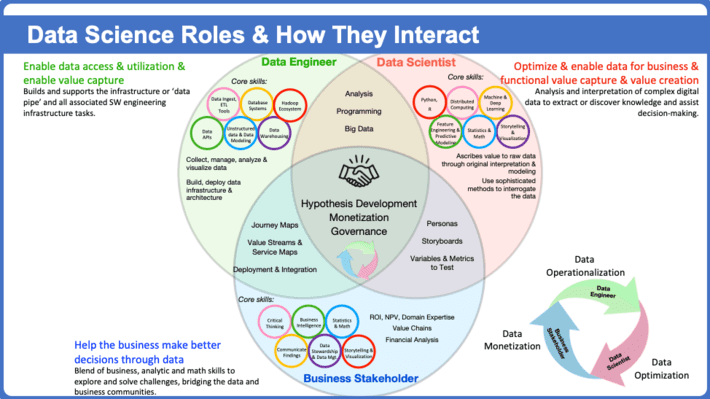
Note: check the Appendix for more details on the characteristics of each of these three data science roles.
We now need to empower this extended team to create actionable customer, product and operational insights. Next, the CEO needs to champion an organization-wide data science mindset to get everyone to “Think Like a Data Scientist”.
Step 2: Create a Data Science Mindset and Discipline
The CEO should not only understand where and how to apply data science to power the business, but the CEO must champion an analytics-centric approach toward decision-making across the entire organization by teaching everyone to “Think Like a Data Scientist” (see Figure 2).
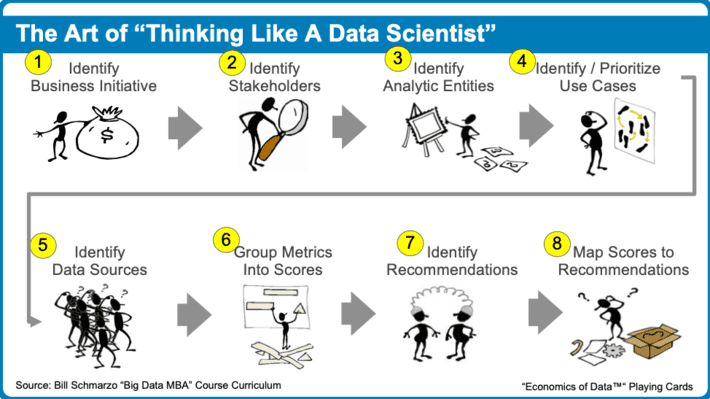
The value of data isn’t having it but derived in how the organization uses the data to create new sources of value. To exploit the economic portion of data, Executives need to transition from a data-driven mindset (focused on amassing data) to a value-driven mindset (focused on exploiting the data to derive and drive new sources of customer, product and operational value). Next, the CEO needs to embrace a common, collaborative-centric data science engagement methodology.
Step 3: Employ Collaborative Data Science Engagement Methodology
While our goal is not to turn our Business Stakeholders into data scientists, we do want to train them to “Think Like a Data Scientist”. That way the Business Stakeholders can understand how best to collaborate as part of the data science team to uncover the customer, product, service and operational insights that will drive business success. This means educating and indoctrinating the Business Stakeholders into the highly non-linear, fail fast / learn faster, exploration-centric, “all ideas are worthy of consideration” data science engagement process (see Figure 3).
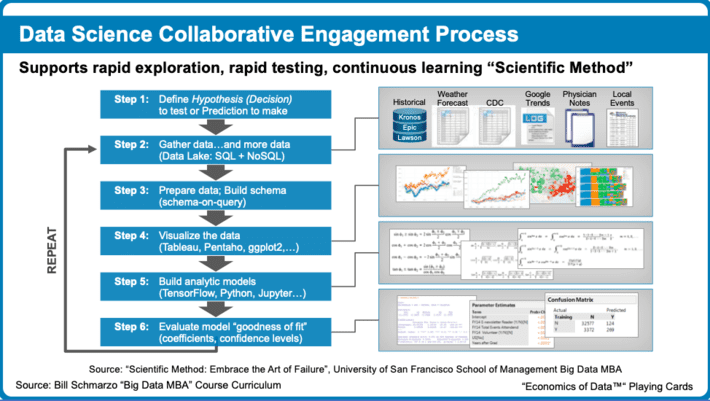
To be successful, this process requires that the business stakeholders, those people who really understand the customer or operational situation, be involved on day zero. They are not just on the boat but must be at the front of the boat to ensure that the data science process is delivering something relevant and meaningful to their jobs, their customers, and their operations.
For example, the Data Science Hypothesis Development Canvas cannot be created without the close involvement of the Business Stakeholders to validate the hypothesis that we are seeking to prove, identify the metrics against which progress and success will be measured, identify and prioritize the decisions and predictions, and articulate the costs of False Positives / False Negatives against which the analytics model will be determined to be “good enough.” Next, the CEO needs to nurture a Design Thinking culture.
Step 4: Empower the Entire Organization with Design Thinking
Maybe the biggest challenge the modern CEO faces is the realization that the best business ideas will come from those workers closest to the customers and operations. This means creating a culture where the subject matter experts (technician, engineers, operators, nurses, teachers) closest to the customers or operations are tightly integrated into the value engineering process in order to capture, validate, codify and augment front-line intelligence.
Design thinking is a human-centric design that builds upon the deep understanding of users to generate ideas, build prototypes, share learnings, embrace the art of failure and “try out” the solution. And fortunately for us humans (who really excel at human-centric things), there is a tight correlation between the Design Thinking and Data Science(see Figure 4).
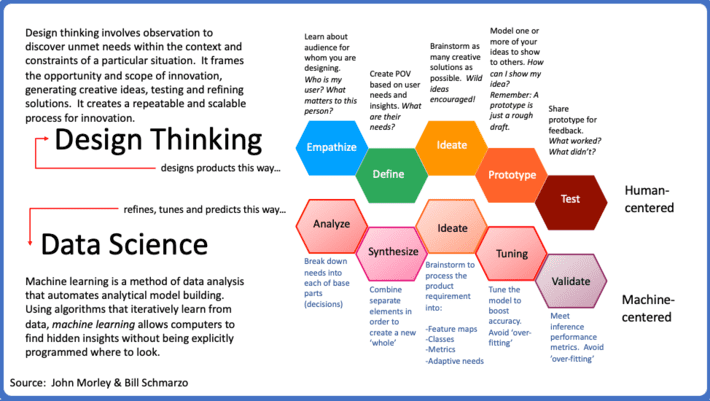
This means really embracing design thinking as an organization – running your meeting and developing product plans and resolving customer problems using Design Thinking …and not just saying the words. Finally, the CEO needs to drive their digital transformation with the most powerful concept in business…economics.
Step 5: Develop Plan to Exploit the Economics of Data and Analytics
“In much the same way that oil fueled the economic growth of the 20th century, data will fuel the economic growth of the 21st century. Yes, data is the new oil, but much much more…” – Bill Schmarzo
I find that most CEO’s struggle to look at data from an economics perspective. They have been trained to think about value creation from an accounting perspective. But accounting is a retrospective-looking methodology for determining asset valuation based upon the acquisition cost of an asset.
Economics, on the other hand, brings a forward-looking perspective on determining asset valuation. Organizations that use an economics frame to measure and manage their business operations focus on the value or wealth that an asset can generate or create. Not only does economics provide a forward-looking valuation frame, but the unique characteristics of digital assets (data, analytics) exploit that economics frame further (see Figure 5).
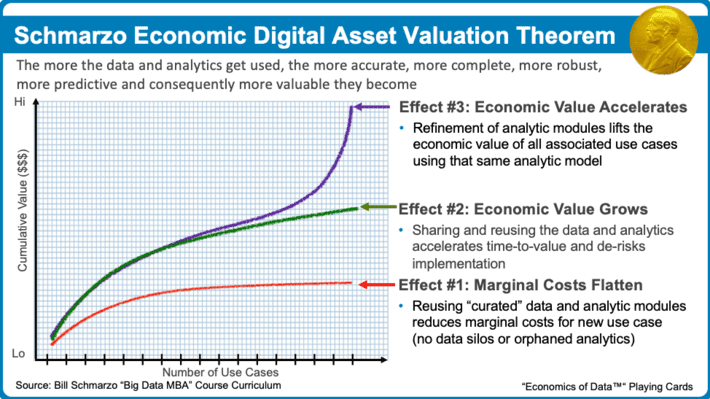
The unique economic characteristics of data and analytics manifest themselves into a larger economic theorem – the “Schmarzo Economic Digital Asset Valuation Theorem” – that takes into account a digital assets unique ability to simultaneously drive down marginal costs while accelerating the economic value creation of digital asset.
The key to flourishing in this digital age is exploiting the unique economic characteristics of digital assets that not only never deplete, never wear out and can be used across unlimited use cases at zero marginal cost, but who value actually appreciates, not depreciates, the more that they are used and the learning that they gain from that usage.
Summary: CEO Digital Transformation Survival Guide (aka “Forewarned is Forearmed”)
CEOs of the world, there’s no need to worry about what evil lurks in dark spaces if you follow these 5 simple steps to illuminate the path to digital transformation. No dark basements where asset determination is limited to an accounting mentality. No dark attics for which only the most senior executives know how to navigate. No dark woodsheds where data science is an organizational function and not an organizational discipline. No dark garages where only the most senior executives have the best ideas.
So, what are you going to do to navigate these dark spaces that drive feelings of horror? How instead is your organization going to embrace a transformational mentality that turns those fears into an elixir that brings fortune to everyone (though I will still refuse to watch Tom Cruise in that God-awful, horrific “War of the Worlds” remake)?
Appendix
To understand the specific differences between each of these three roles, my colleague John Morley did some research reviewing job profiles of Data Engineers and Data Scientists at some of the Silicon Valley’s leading data science organizations. John’s work is summarized in Figure 6. Yes, it may be an eye-chart, but it is brilliant.
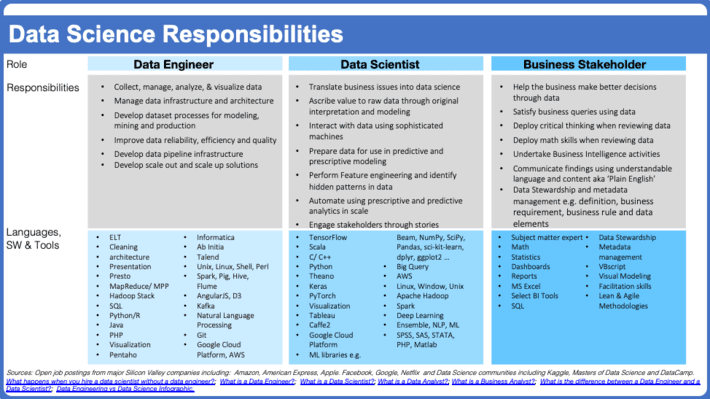
This is a great foundation that helps us understand what skills we are going to need to hire and/or develop.
